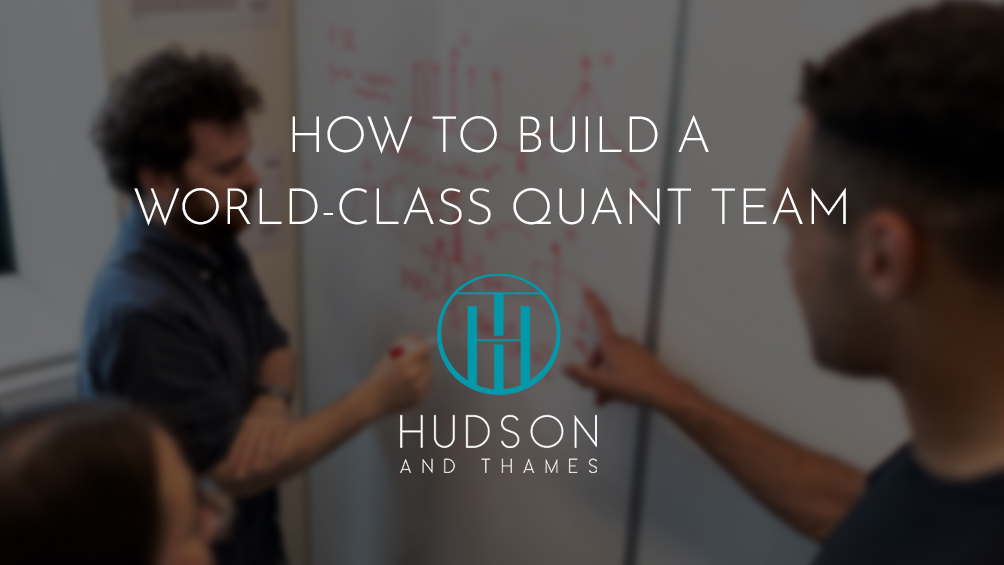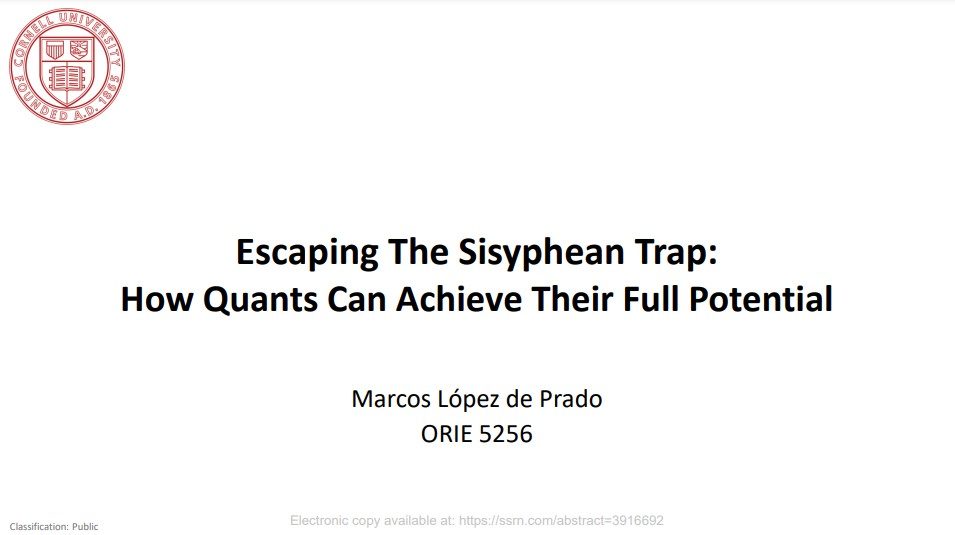How to Build a World-Class Quant Team
by Dr. Randle Rabe
Join the Reading Group and Community: Stay up to date with the latest developments in Financial Machine Learning!
Introduction
Building on our last article regarding best practices for quantitative finance research groups, this article asks the question:
What is the best setup and culture for a quant team?
This question may have different answers depending on who you ask.
Fortunately, there are some glimpses and statements from the top quantitative research groups that afford us a window into their work environment behind the scenes. For this short article, we have scraped the internet for some fascinating insights into the structure and culture of some of the best performing quant hedge funds in the world.
Insights from Some of the Best Quant Hedge Funds
⠀
PDT Partners
PDT Partners is a renowned quant investment company that was founded in 1993 by Pete Muller, a young mathematician, inside Morgan Stanley (originally as PDT). In 2013, PDT spun out of Morgan Stanley to become PDT Partners. It has over $11 billion AUM.
A few interesting insights from the employees at PDT Partners are given on their webpage Work | PDT Partners.
One employee remarks that:
PDT is not a place like a typical finance trading company. It’s a sort of science-based enterprise. The people who make the decisions here are scientists using the scientific method. The way we operate stems from that.
Another employee mentions that:
We’re given a lot of freedom to try out ideas, to prototype something, see if it works, see if you can make a better version. That’s a really big aspect of working at PDT.
Finally, the mentioned webpage also states similar ideas:
PDTers are encouraged to ask questions, set their own goals, and hold themselves to high standards. We avoid micromanagement and top-down command and control.
The D.E. Shaw Group
We next take a look at The DE Shaw Group, which is a global investment and technology firm. It was founded in 1988 by David E. Shaw, a computer scientist. The fund has about $60 billion AUM.
Commenting on the environment at the D.E. Shaw Group, a trader states that:
Problem-solving at the D.E. Shaw Group is collaborative, is what I think is the best word. When we have a hard problem, we will often get together in a group, or we’ll do it over email, but we will get a bunch of names, a bunch of people involved…I would say that the way we approach problem-solving makes it so much more research-focused that you feel like you are almost in an academic institution.
This same sentiment is expressed on the D.E. Shaw webpage, which says that “the firm prizes a culture of collaboration across disciplines, geographies, and investment strategies.”
Renaissance Technologies
Perhaps the most legendary quantitative hedge fund is Renaissance Technologies.
Started by mathematician Jim Simons, Renaissance Technologies’ Medallion fund has seen huge returns of 71.8% on average (before fees) between 1994 and 2014. The fund is entirely model-driven, with quantitative research performed by an army of scientists from STEM fields. The Medallion fund has about $34.8 billion (regulatory) assets under management (AUM).
In an excellent interview, Simons provides some small insight into the setup of Renaissance Technologies:
My algorithm has always been, you get smart people together, you give them a lot of freedom, create an atmosphere where everyone talks to everyone else (they are not hiding in a corner with their own little thing, they talk to everybody else) and you provide the best infrastructure, the best computers and so on that people can work with, and make everyone partners.
Man AHL
Another giant in the quant space is the systematic investment manager is Man AHL, which is a part of the larger parent Man Group (which was founded in 1783 by James Man), which has used momentum strategies (amongst others) as its flagship approach for over three decades. As of 2021, Man Group manages about $123.6 billion AUM.
In this video promotion of Man AHL, we get an indication of the type of environment that exists within Man AHL. Commenting as CEO, Sandy Rattray describes the environment as follows:
Our researchers are completely unconstrained and can look at whatever markets and whichever models they think we can find alpha in. We foster a highly creative and energetic environment.
Adding to this, the environment is set up to be challenging. Commenting on this aspect, Giuliana Bordigoni describes the following:
…we push boundaries, no matter if something is difficult. If it is worthwhile, we are going to find a way of doing it. I like to be challenged and I like to find solutions to problems, and this mindset is shared by all the people at Man AHL.
Two Sigma
Two Sigma was founded in 2001 by computer scientist David Siegel and mathematician John Overdeck. The fund has over $58 billion AUM.
A video by various Two Sigma employees paints a similar picture to the previous cases. Some key points from the video are that the environment is described as collaborative and creative and there is a culture of learning.
An employee states that:
We really are believers that if you get people with different sets of skills together around a problem, with diverse opinions and sort of encourage and foster those diverse opinions, that creates a better result.
Another employee mentions that:
It’s so great to walk up to a person and basically mine them for this and they’re very happy to share. And so, many of the products that we build are very effective collaborations across teams in this company.
Citadel Securities
The final group that we will look at is Citadel Securities, which was founded in 1990 by Kenneth C. Griffin and today manages over $43 billion dollars in capital.
Some interesting comments can be found in some of their employee interviews. Commenting specifically on their quantitative research, one employee states that:
Different team members have different expertise. Naturally, we need to collaborate with a lot of people across teams and also within teams.
In another interview, a quantitative researcher states that
At Citadel Securities, we’re extremely good at mapping people to tasks that they are particularly talented and well-suited for…this divide and conquer strategy is one of the oldest tricks in the book. And I think our culture allows us to do that particularly well.
The Sisyphean Quants: Insight from an Industry Expert
Outside of these groups, there are also some interesting points made by Marcos Lopez de Prado, an industry leader in the application of machine learning techniques to finances that we wish to share.
In a presentation titled The 7 Reasons Most Machine Learning Funds Fail, Marcos Lopez de Prado gives recommendations for how a quantitative research group should optimally function and has some fascinating overlap with the cultures of the companies we looked at.
In the first part of his presentation, he describes a pitfall that calls “the Sisyphean quants”. He starts by describing the work structure for the case of discretionary portfolio managers, that do not follow a particular theory or rigorous rationale, to make their investment decisions. Since their decisions are not systematic (they are discretionary), the portfolio managers work in silos. That is, they work in isolated pods with respect to the other portfolio managers in the group, with each manager using their own discretion to make profitable strategies. Thus, since their conclusions on investments/trades may be different, hedge funds use the siloing technique for diversification and to better the chances of success (secrecy inside hedge funds also plays a role in this structure).
However, for a quantitative (or systematic) fund, this approach does not work. This is because quants try to apply the scientific method to their strategies and, therefore, should be able to reach objective conclusions. In scientific fields, the structure is very open and collaborative. More often, to solve a research question, scientists will work in various teams that consist of researchers from other groups and even other fields. This fosters a culture of collaboration, debate, and reaching common conclusions about research questions. This approach has been hugely successful in the scientific community.
In his presentation, Lopez de Prado mentions that a fund starting a quantitative research group may be inclined to use the older approach for discretionary managers. He remarks that this is highly likely to lead to failure, describing this setup as “the Sisyphean quants” (this is in analogy to the Greek mythological character Sisyphus, who was punished for eternity by Zeus to roll an immense boulder to the top of a hill, only to see it roll down again). In particular, he says that
Firms directing quants to work in silos, or to develop individual strategies, are asking the impossible. Identifying new strategies requires large teams working together.
He also mentions that this does not mean you can’t succeed on your own, but that it is becoming increasingly difficult to succeed for an individual setup.
In addition, Lopez de Prado also mentions that efficiently dividing the tasks to people that are experts in each task is a powerful approach (in contrast to trying to get each person in your quantitative research group to be an expert in everything).
Conclusion
The above quotes and references give us some great insight into the structure and culture of some of the best quant funds in the world. These insights appear to align well with the comments made by Lopez de Prado.
For these successful quant funds, the evidence points towards a scientific culture instead of a typical financial one (as in the example of the discretionary fund discussed by Lopez de Prado). The quant funds above all have open environments that foster collaboration and discussion between its different groups. Employees describe this environment as academic in nature, further drawing the comparison to a scientific environment.
Team members with special skill sets frequently assist other quant teams in solving their tasks (in contrast, the discretionary funds discussed by Lopez de Prado take a siloing approach).
Finally, a complex task should be divided into many simpler sub-tasks. These sub-tasks are then assigned to team members that are experts in solving these problems. This is a highly efficient method of distributing the brainpower in your quant team.
References
- Ahmad, N. (no date) Pdt Partners Review, SmartAsset. Available at: https://smartasset.com/financial-advisor/pdt-partners-review.
- Celarier, M. (2021) The Medallion Fund is Still Outperforming. Other Renaissance Funds Still Aren’t. Institutional Investor. Available at: https://www.institutionalinvestor.com/article/b1rgwjlwfqccst/The-Medallion-Fund-Is-Still-Outperforming-Other-Renaissance-Funds-Still-Aren-t.
- D. E. Shaw group (no date). Available at: https://www.deshaw.com/ (Accessed: 21 January 2022).
- Haran, B. (2015) James Simons (full length interview) – Numberphile. Numberphile2. Available at: https://www.youtube.com/watch?v=QNznD9hMEh0.
- Man Group Sees 2020 AUM Hit Record (2021). Funds Europe. Available at: https://www.funds-europe.com/news/man-group-sees-2020-aum-hit-record.
- Nickolas, S. (2021) Jim simons’ success story: net worth, education, and top quotes, Investopedia. Available at: https://www.investopedia.com/articles/investing/030516/jim-simons-success-story-net-worth-education-top-quotes.asp.
- The 7 Reasons Most Machine Learning Funds Fail Marcos Lopez de Prado from QuantCon 2018 (2019). Quantopian. Available at: https://www.youtube.com/watch?v=BRUlSm4gdQ4.
- Two Sigma (no date). Available at: https://www.twosigma.com/.




